Right: 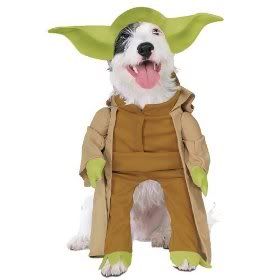 Star Wars Yoda Pet Dog Halloween Costume
Star Wars Yoda Pet Dog Halloween Costume
Whether you like it or not, pet Halloween costumes have gained huge popularity and so many dog owners are joining in the trend to outfit their pets for Halloween.
However, not all costumes are designed for pets.
Safety and comfort are critical when picking a Halloween pet costume. Breathing and movement should not be restricted or impaired.
Some pets will take to costumes immediately while others need to be trained to accept them.
Many Halloween pet costume manufacturers have guides to sizing (such as the one below) but to get a proper fit it is best to try the costume on.
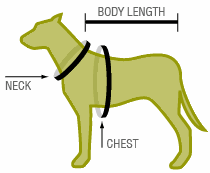 Neck: Measure the neck length as you would for a collar but remember that a costume should be much looser around the neck.
Neck: Measure the neck length as you would for a collar but remember that a costume should be much looser around the neck.
Chest: – Measure around the chest at the widest area (right behind the front legs). Again allow extra space for a comfortable fit and movement.
Body Length: – Measure along the backbone from the base of the head to the base of the tail. (From where the collar rests to where the tail connects to the body.)
If neck, chest and body length measurements are listed on the size chart for an item, take into account all the measurements and choose the item that best matches. If not, the chest measurement is a good guide.
You can get a pet to wear a pet costume by habituating (training) the animal to the costume before you get the actual costume–by using other clothing.
However the ideal situation is to use the actual Halloween pet costume–especially if there is head gear or material that fits over legs or other parts of the body AND if your pet does not usually wear clothing.
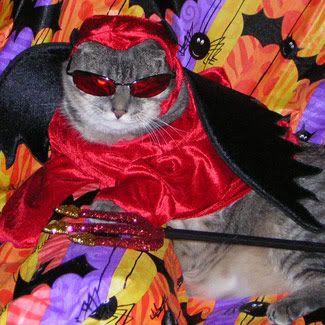 Now the best technique is to purchase the Halloween pet costume early so that training can be done in short increments over a couple of weeks–but if you are like most people you probably have waited until the last minute!
Now the best technique is to purchase the Halloween pet costume early so that training can be done in short increments over a couple of weeks–but if you are like most people you probably have waited until the last minute!
On your quest for the best pet Halloween costume, take your pet with you to the pet store or pet boutique so you can try the costume.
Some stores may not let you try it on but you can estimate the size by holding it up to the pets body.
Once you actually purchase the costume, check to make sure that the holes around the head, neck, feet, and tail are not restrictive.
If it feels tight anywhere it may be uncomfortable or hazardous to your pet. You can do a bit of altering if necessary.
To train your pet to accept the Halloween pet costume take the following steps:
- First, let the pet sniff the costume and treat for interest.
- Next, begin draping the costume over his or her back and treat for tolerance.
- Then, put the costume on and immediate take it off–giving treats during cooperation and just as you begin putting it on.
- Increase the duration of time the pet wears the costume and treat the pet while he or she is adorned in the outfit.
- If you are working with a dog, ask for a sit, down, and then go for a short walk while the dog is wearing the costume to ensure that movement and breathing are not impaired.
- If your pet accepts the costume, allow him or her to wear it around the house under supervision.
- Make sure you praise and treat for the animal for tolerating the pet costume.
Most pets learn that they get a lot more attention when dressed up and will enjoy the extra fuss made over them when they wear a Halloween pet costume. This creates a positive association with the costume and is rewarding in itself.
Note: If your pet does not like the costume, continually attempts to remove it, or if he or she seems unhappy or uncomfortable even after your work training the pet to accept the costume–do not force the animal to wear it. Instead, use a decorative bandanna or festive collar and leash set instead.
Other Halloween Pet Costume Safety Tips
Be sure to always supervise pets when they are wearing a Halloween pet costume and don’t leave them unattended even for a moment.
If you are heading out into the night for trick-or-treats, get a reflective leash or tags and attach reflective patches to the pet’s costume
Taking the time to acclimate your pet to wearing a Halloween pet costume is humane and can make sure everyone has a great time.
 So, I have to at least explore some of the pet costumes out there. Also, I want you to be able to identify the expressions of pets who like their costumes and those who don’t.
So, I have to at least explore some of the pet costumes out there. Also, I want you to be able to identify the expressions of pets who like their costumes and those who don’t.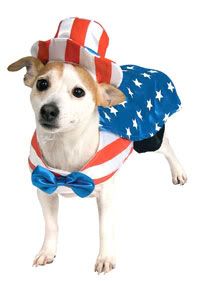


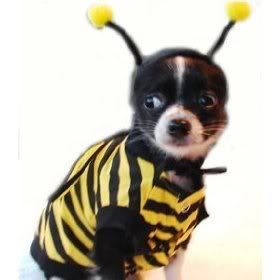 Below you can see the difference between the dogs wearing
Below you can see the difference between the dogs wearing 
